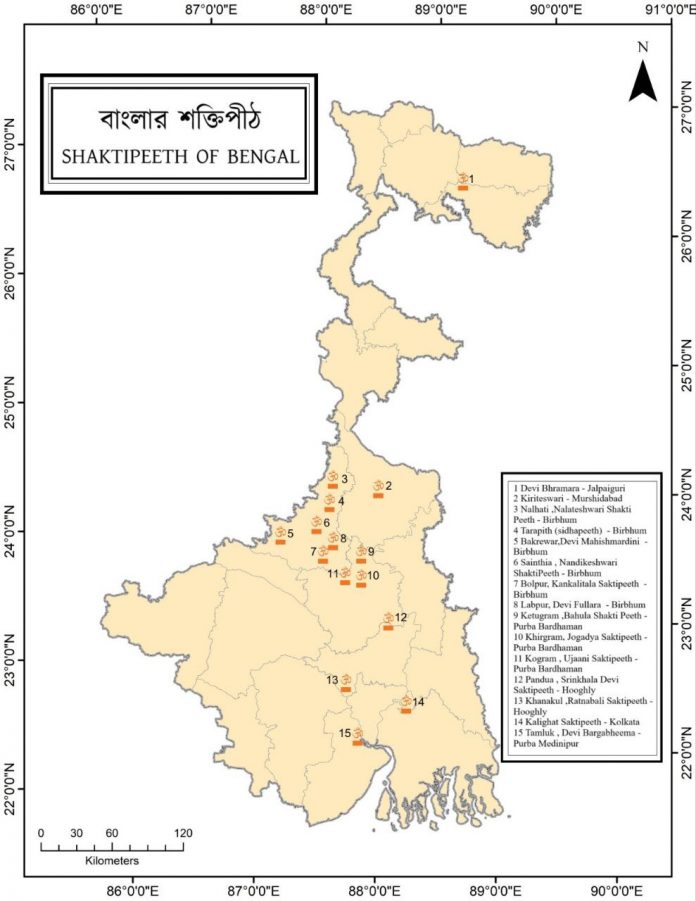Introduction: The Sacred Land of the 51 Shaktipeeths (Shakti Kumbh)
According to Hindu Puranas, following the self-immolation of Goddess Sati, Lord Vishnu used the Sudarshan Chakra to dismember her body into 51 parts to stop Lord Shiva’s destructive cosmic dance (Tandava). These 51 spots are revered as the holy Satipeeths or Shaktipeeths (seats of power). Within undivided Bengal, there were 19 such sites, and today, the state of West Bengal alone is home to 14 of these primary Shaktipeeths. This “Motherland” (Janani Janmabhumi) is thus a major hub of Shakta worship (Shakti Kumbh).
The Event Concept: The Confluence of Shakti and Shiva (Shakti Kumbh) :
We are proposing a grand initiative to symbolically unite the 14 Shaktipeeths of West Bengal, the great pilgrimage site Tarapith (Siddhpeeth), and the two vibrant centers of worship in Kolkata, Dakshineswar and Adyapeath, onto a single, prestigious platform. This collective event is named “Shakti Kumbh.”
This “Shakti Kumbh” will serve as the high-profile launch event for the upcoming Triveni Kumbh Mahotsav. We draw a profound parallel: just as the Triveni Kumbh signifies the union of the holy rivers Ganga, Yamuna, and Saraswati, we liken this event to Lord Shiva, the supreme force of creation, preservation, and dissolution. And where Shiva resides, the Mother Goddess, the true embodiment of cosmic energy (Shakti), is omnipresent.
Symbolic Confluence of Shiva and Shakti :
The event establishes a powerful theological link with the main festival:
We recognize the Triveni Kumbh as embodying the spirit of Lord Shiva (the cosmic principle).
The Shakti Kumbh asserts that where Shiva resides, the Mother Goddess (Shakti), the true reservoir of dynamic energy, must also be acknowledged and revered.
The event seeks to celebrate this sacred union of Shiva and Shakti—the fundamental principle of cosmic existence—thereby providing a deep spiritual meaning to the upcoming Mahotsav.
The 17 Revered Sites Highlighted in Shakti Kumbh : The event theme centers on the geographical and spiritual confluence of 15 recognized Shaktipeeths and the major Siddhpeeth, Tarapith, Dakshineswar , adyapeath emphasizing the Divine Feminine energy (Shakti) that permeates the state.

The 17 revered sites to be highlighted are:
1. Kalighat – Kolkata
2.Kankalitala – Birbhum (Bolpur, Nanoor)
3.Fhullara – Labhpur, Birbhum
4. Nandikeshwari – Sainthia, Birbhum
5 .Bakreshwar – Birbhum (Rajnagar, Siuri)
6 . Nalhati – Birbhum
7 .Yogadya – Kshirgram, Purba Bardhaman (Katwa)
7.Devi Bahula – Ketugram, Purba Bardhaman
8.Mangala Chandi – Kogram Ujani, Purba Bardhaman
9.Attahas – Niral, Purba Bardhaman
10. Kiritashwari – Murshidabad
11.Devi Bhramari – Jalpaiguri
12.Ratnavali – Khanakul, Hooghly
13.Devi Shrinkhala – Pandua, Hooghly
14 . Devi Bargabhima – Tamluk, Purba
Medinipur
15.Tarapith (Siddhpeeth) – Birbhum
16.Dakshineswar – Kolkata
17 .Adyapeath – Kolkata
Cultural and Academic Dimensions :
“Shakti Kumbh” is designed to be a vibrant confluence of knowledge, art, and spirituality, extending beyond a mere religious gathering:
Academic Discourse: Academic discussions and seminars will be held with scholars and researchers focusing on the history of the Shaktipeeths, Tantra philosophy, and Shakta traditions.
Classical Performances: Showcasing classical art forms dedicated to the worship of the Goddess, such as the classical Gauriya Nritya, devotional Shyama Sangeet, and the vibrant Kali Kirtan, celebrating the glory of the Shaktipeeth heritage.
Visual Arts: An exhibition of Visual Arts will be organized, inspired by the architecture, mythological narratives, and various forms of the Divine Mother associated with the Shaktipeeths.
The two-fold objective of the “Shakti Kumbh” is:
Reawakening Consciousness: To rejuvenate the collective spiritual and cultural awareness (Chetana) of Bengal’s unique position as the heartland of Shakta philosophy.
Official Launchpad: To formally announce the dates and unveil the calendar for the highly anticipated Bangiya Triveni Kumbh Mahotsav 2026.
Impact: The event’s uniqueness—uniting 17 sites for the first time—combined with the major public announcement of the Triveni Kumbh 2026 dates, guarantees immediate and massive media attention, establishing it as a crucial landmark event in Kolkata.
Smriti O Chetana’s Pledge: Igniting Bengal’s Cultural Renaissance :
Smriti O Chetana (SOC), as an organization deeply invested in preserving and invigorating Bengal’s spiritual and cultural fabric, firmly believes that the “Shakti Kumbh” launch event is not merely an undertaking—it is a visionary imperative and a guaranteed “Park Breaking” moment for the region.
We are launching this event because nobody has conceived of this unique idea before. By daring to symbolically unify the dispersed yet sacred geography of Bengal, we are ensuring that this initiative will immediately grab the attention of people all around Bengal and beyond.
SOC’s core conviction rests on the power of Smriti (Memory) and Chetana (Consciousness). For too long, the supreme spiritual power of Bengal has been viewed through fractured lenses, with individual pilgrimages to scattered sites. The Shakti Kumbh changes this narrative.
Conclusion: A New Spiritual Era :
The Shakti Kumbh is more than an inauguration; it is SOC’s declaration that Bengal’s spiritual inheritance is whole, alive, and ready to be celebrated. By focusing on the powerful unity of the Divine Feminine, SOC will not only ensure that the event captures the imagination of the public but will also lay a strong, conscious foundation for the monumental Bangiya Triveni Kumbh Mahotsav 2026.
Also Read : Surul Raj: A Legacy of Power, Faith, and Land in Colonial Bengal
Pallab Mondal
